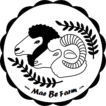Mae Be Farm Happenings
March 2020
Happenings on the Farm
March is a really busy month here on Mae Be Farm. This year we have several really fun events happening in March.
The first event will be lambing! Lambs are due arrive starting March 6th but all babies arrive on their own time so we’ll see. This is one of my favorite times of the year even though it’s one of the most exhausting times. There is very little that can compare with the joy of a new mom with her babies. Very quickly my barn and pasture are filled with bouncing, running excited babies and everything is a playground. It is also fun to see who produces what. I have a lot of color in my flock so you never quite are sure what beautiful colors and patterns are going to appear this year. It’s an adorable time of the year so keep watching Mae Be Farm’s facebook page for all the latest babies.
On the 21st we are hosting our annual open farm day for those who want to come visit the babies. The barn will be open from 9am to 1 pm so come when you can. Children are welcome. We will have babies and moms that you can pet and get pictures with.
On the 24th is a special story time at the Keewaydin Library, featuring a couple of Mae Be Farm’s lambs! The kids will get to meet the lambs and learn all about sheep farming. It will be a fun time!

March 28th is the first Spinning with Intent meeting. We will be meeting at Desert Fiber Arts from 9 am to 1 pm. This week is getting to know you and your wheel. All spinners of any ability are welcome to join us as we all hone our spinning skills. For more information please email me at maebefarm@gmail.com or on facebook at @MaeBeFarm.
And last but not least on March 29th we have our annual shearing. We have a professional shearing coming from Oregon to shear our flock. Its amazing to watch. It is surprising to see how much wool comes off of the each sheep, and how small they look after their hair cut. If you’d like to come watch shearing please email me at maebefarm@gmail.com or on facebook at @MaeBeFarm.
On the Needles
All the yarn is spun for the great shirt project! There are 37 skeins of yarn pictured with a total of 3,939 yards of two ply yarn. That means I spun 11,817 yards total or 6.7 miles of yarn. My poor wheel.

Each skein took 1 hour 35 minutes average to spin and wind into a ball ready to ply. It took an average of 44 minutes to ply the yarn and wind into a skein (I didn’t count the one that slipped off the nitty notty and tangled into one supreme amazing yarn barf of a mess). So with a little math it took 58.6 hours to spin all the singles and 27 hours to ply the yarn for a grand total of 85.7 hours! If you then multiply that by Washington’s minimum wage of $12 per hour that means my wages would have cost $1,028.40 so far.
The adventure for this month will be dying all the yarn. It took a lot of thought to figure out how much yardage I should dye for each color. This is the plaid:
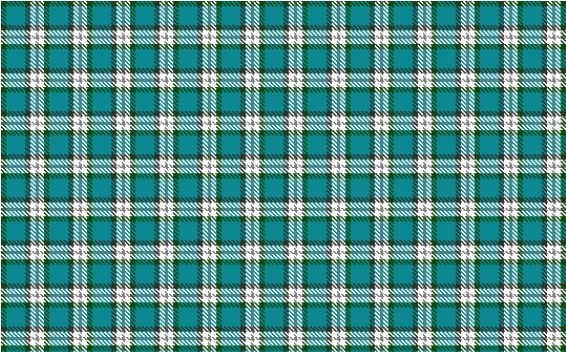
There are 4 colors: Black, Teal, White, and Grey. The pattern is 40 strands and at 8 epi that means the pattern is 5 inches wide which means there are 8 repeats across the warp. Each repeat has 8 black strands, 16 teal strands, 12 white strands and 4 grey strands. Which means that there will be a grand total of 64 black, 128 teal, 96 white, and 32 grey. Multiply that by the length of each warp strand and you get: 357 yards of black, 714 yards of teal, 536 yards of white, and 179 yards of grey. That’s the warp, now we need to calculate the weft.
For the weft there will be 38 repeats (189 inches long/ 5 inch pattern). Repeating the color calculations you get: 304 black, 608 teal, 456 white, and 152 grey. Since each strand is 42 inches wide you get: 356 yards black, 710 yards teal, 532 yards white and 178 yards of grey.
With the warp and weft
added together I need to dye: 661 yards of black; 1322 yards of teal; 1068
yards of white; and 357 yards of grey.
March 2020
| Sunday | Monday | Tuesday | Wednesday | Thursday | Friday | Saturday |
| 1 | 2 | 3 | 4 | 5 | 6 | 7 |
| Lambing Starts! | ||||||
| 8 | 9 | 10 | 11 | 12 | 13 | 14 |
| 15 | 16 | 17 | 18 | 19 | 20 | 21 |
| Spring on the Farm – come visit the lambs! | ||||||
| 22 | 23 | 24 | 25 | 26 | 27 | 28 |
| Lambs at the Library! | Spinning with Intent – Getting to know you | |||||
| 29 | 30 | 31 | ||||
| Shearing at Mae Be Farm | ||||||
List of Events:
March 6th Lambing Starts
March 21st Spring on the Farm – come visit the lambs! 9-1
March 24th Lamb Story Time at at Keewaydin Library 11-12
March 28th Spinning with Intent – Getting to know you 9-1 at DFA
March 29th Shearing at Mae Be Farm
April 4th Wool Skirting Class 9-1
May 2nd Ritzville Fiber Fest
May 9th Fiber with a Twist
Sudoku
| 1 | 9 | |||||||
| 4 | 9 | 1 | 7 | 2 | ||||
| 3 | 5 | 4 | 8 | 1 | ||||
| 9 | 6 | 3 | 7 | |||||
| 1 | 7 | 3 | 6 | 4 | 9 | |||
| 3 | 9 | 8 | 2 | |||||
| 2 | 7 | 4 | ||||||
| 6 | 9 | 4 | 1 | 3 | 5 | 7 | ||
| 7 | 2 |
Answer to last month’s riddle: A fence
All Riddled Up
What is seen in the middle of March and April that can’t be seen at the beginning or end of either month?
Love to Laugh
What’s the best way to cook an alligator?
In a crock-pot!
What do you call a sad pup?
Mellon Collie!
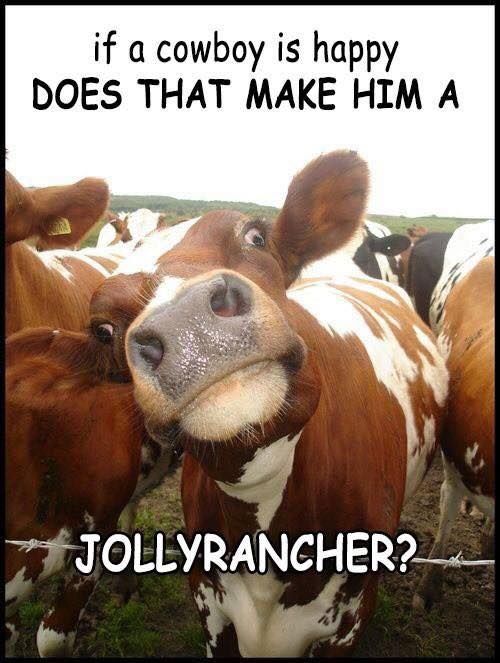
Lad’s Barking News
This month is a busy month for us. Last year was my first year lambing and I learned a lot. I learned that I better not annoy the mama sheep because they can be very mean. I don’t mean to harm their lambs but they are afraid anyway. I just want to inspect the babies. They are going to be part of my flock and I can’t wait to meet them. It also looks like fun to lick the babies, can I try?
Last year I got to help with the bottle babies. They were lots of fun. I cuddled them when they were upset and played with them when they were happy. They taught me how to jump like a lamb. I made my girl laugh so hard she cried. My favorite part was washing their face after they had their bottles. They were messy eaters and needed a lot of licks. Besides the milk was yummy. I tried to drink one the bottles but it was against the rules. Sad.

When they got a little older the bottle lambs helped me learn how to herd sheep. They were very patient with me and let me boss them around a lot. I liked that. I’m hoping we can have more bottle babies this year.

I’m not so excited about shearing. It was kind of scary last year. There was a lot of moving and places I wasn’t allowed to go and new rules and new sounds. I was scary to see all those naked sheep. They didn’t look like my ewes anymore. I spend a long time watching and learning that day and this year I’m told I get to help with the sheep. I like that. Bossing sheep is my favorite job and now that I’m better at it I get to do lots of it! I may even get in the video that my girl is making about shearing so watch for me!
Meet the Animals of Mae Be Farm

Brugge came to Mae Be Farm from Tawanda Farms down in California. He is a 4 year old natural colored purebred Romney Ram and an absolute sweet heart of a ram. Last summer he took care of a hen and her 10 chicks (look closely and you’ll see all the little feet under the hen). She was perfectly safe from everything with him watching over them. It was funny to see a 300 lb ram tip toeing around tiny bantam chicks, watching each step to avoid stepping on a baby.
Last year was our first lambing out of him and he gave us some really beautiful colors and wonderful wool on the lambs.
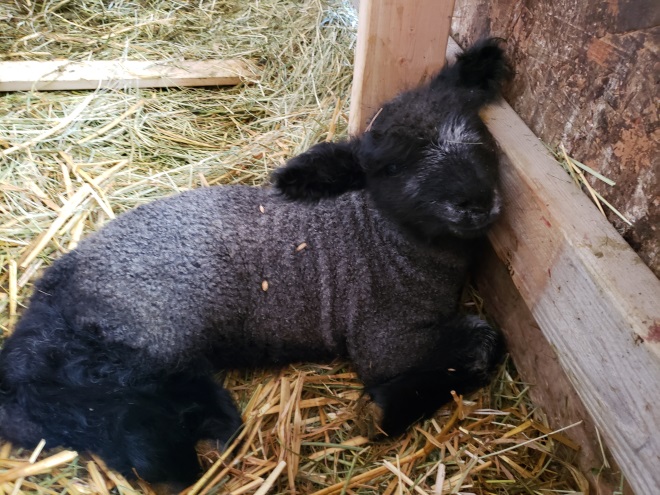
One of Brugge’s lambs showing off her grey wool and cute facial markings.
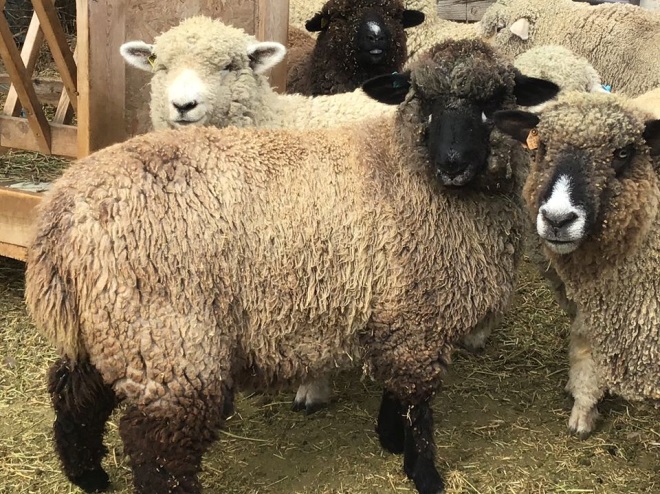
I kept a ewe lamb out of him Merida (pictured above as a 8 month old lamb) and am excited for the upcoming shearing. She is grey under all that brown.

Brugge’s wool is a lovely grey with a nice hand. He’s bred to produce a prime handspinning fleece and boy does he deliver. His wool has a bold crimp and well defined medium to long locks. It has a very nice hand and makes lovely yarn.
What is a lambing jug and why use it?
Lambing is fast approaching and the lambing jugs are up. What is a lambing jug you ask? Well I’m glad you asked. A lambing jug is a small pen where the ewe and her lambs stay for a few days. On some farms the ewe will give birth in the pen too, but on here we have what we call the maternity ward which is a slightly larger pen where several ewes who are close to lambing spend their time until they lamb. Then they go into the lambing jug.
Lambing jugs are the private rooms of the sheep world. They allow the lambs the time they need to bond with their mother and get practice at moving in outside world. This is very important for several reasons.
The biggest reason, bonding with their mother, is life or death for a lamb. In the wild mother animals wander off from the main group and find an isolated place to give birth and spend a while with their newborns. In a farm setting, with sheep this is very undesirable because there are hungry coyotes out looking for the helpless newborns. So we bring them into the sheltered barn and give them their own special room so they can have a chance to bond. During this time the ewe talks a lot to the newborn lambs which teaches the lambs the sound of her voice. The close association also teaches the baby her smell. It’s amazing how the babies know their mother’s voice and will come when she calls even if they can’t see her. The mother too is bonding with her newborns. She won’t allow any other lamb to nurse off her so it’s vital to the lamb that she has a chance to bond with it so she’ll let them nurse.
The jug also keeps the babies from wandering off and getting lost. Lambs are born with a desire to get up and move and sometimes that means that they wander away from their mother. They also tend to fall into things or get stuck in the weirdest places so the jug allows both the shepherd and the ewe to have a rest as well as allowing the baby a safe contained area to practice wandering. Think lamby play pen.
Another reason we use lambing jugs is to keep the baby safe from the other sheep in the flock. Sometimes other moms get confused about newborn lambs and think they are their own (especially when they themselves are close to lambing) and try to steal them. This causes a lot of problems and often results in the lamb becoming an orphan or getting injured. Older lambs are happy to have new friends to play with and aren’t really good at being gentle with the newborn. They can easily knock the new one over or take it too far from mommy.
The final reason (at least for this article) for lambing jugs is it keeps the ewes and lambs close to the shepherd. This closer association allows the shepherd to spot issues with both the ewe and lambs faster and makes any needed treatment easier. One of the most important things we watch for at this time is if the babies are getting enough to eat. Sometimes the ewe doesn’t have enough milk. Sometimes the new mothers don’t know how to feed their baby and allow them to nurse too much or won’t let them nurse enough. The jug lets us get a good look at the newborns to make sure they are safe and healthy. My experienced ewes will take their newborns to the jugs themselves. They know that’s where they get all the food they want and it’s a safe space for them so they don’t stress.
Size, shape and material of lambing jugs are different from farm to farm. The ones at Mae Be are made out of wood 2x4s and are 5X5. They feature an auto fill water trough as well as special hay racks filled with alfalfa hay. The ewes will stay in the jug with their lambs for at least 24 hours and up to 3 days (depending on the ewe’s experience and the lamb’s strength).

Daylight Savings Time
When asked why we have daylight savings time most people will answer ‘it’s for the farmers’. This has always confused me as much as my flock is confused that breakfast is now an hour off so I decided to look more into the origins of daylight savings time.
I’d always heard that Benjamin Franklin had proposed the implementation of daylight savings but a little googling brought me to a Wikipedia article that stated that he had actually published an article in the Journal de Paris “suggesting that Parisians economize on candles by rising earlier to use the morning sunlight.” A premise that reflected his proverb “early to bead and early to rise makes a man healthy wealthy and wise.”. While this is good advice it has nothing to do with changing time, so back to the research.
A little more googling brought me to an National Geographic article that explained that the actual concept of day light savings was created by a man named George Hudson in 1895. He was an entomologist living in New Zealand and “proposed a two hour time shift so he’d have more after work hours of sunshine to go bug hunting in the summer.”
In the United States Congress enacted the first daylights savings law on March 9,1918 during WW1. This contributed to the war effort because people used coal for power and the coal was needed for the war. So changing the clocks and “making” more daylight hours people used less coal. (Incidentally this law also officially set the time zones in the US). While Daylight Savings Time (DST) was used during WW1 and WW2 to conserve fuel they were temporary acts. It wasn’t until April 12, 1966 that it became a permanent institution when President Johnson signed a law.
But why do people believe that DST is for the farmers? It may have something to do with the myth that the DST extends daylight hours. That is false. There are the same numbers of daylight no matter what our clock says. In fact Farmers have always been against DST and were instrumental in getting it repealed after the end of WW1, although some cities still used DST. This happened again after WW2 and the use of DST was very inconsistent. Businesses and transportation companies found this difficult to work with so they pushed for standardization even though the farmers were still quite opposed to going onto DST. In 1966 President Johnson put the whole country on a standardized DST believing that it saved energy and in 2007 Congress extended DST to save more energy.
So does it save energy? According to the Department of Energy the extended DST saved about 0.5% in total electricity use in a day but that varied by how close you were to the equator. A Yale economist studied Indiana and found that there was actually a 1% increase in electricity usage while on DST which cost a estimated $9 million a year. Other studies have varied in the amounts but have shown that there is actually an increase in household electricity usage when DST is in practice.
So I guess the question
is why do we still use DST when it has shown to not only not be for the farmers
(we hate it!) but has shown to have questionable energy savings and is really
bad for our health?
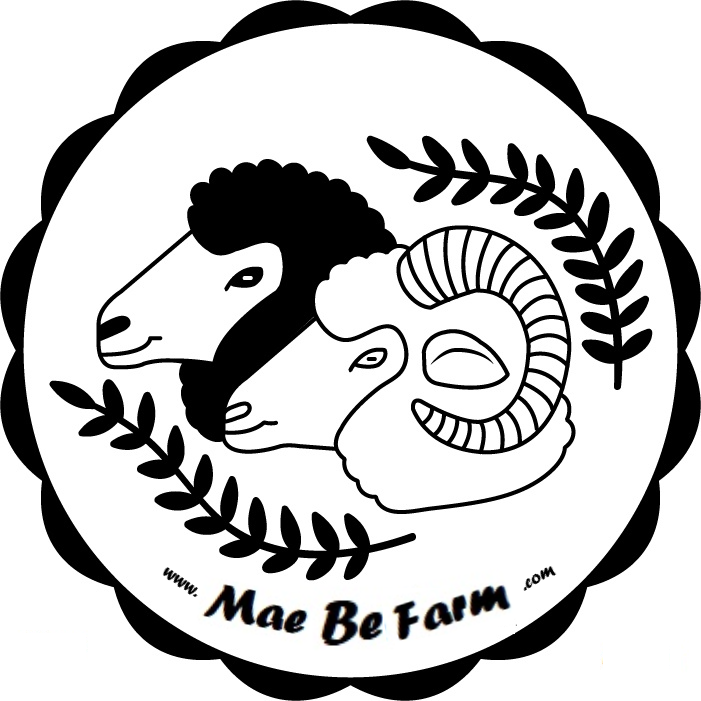
Find us at www.maebefarm.com
and https://www.facebook.com/MaeBeFarm/
